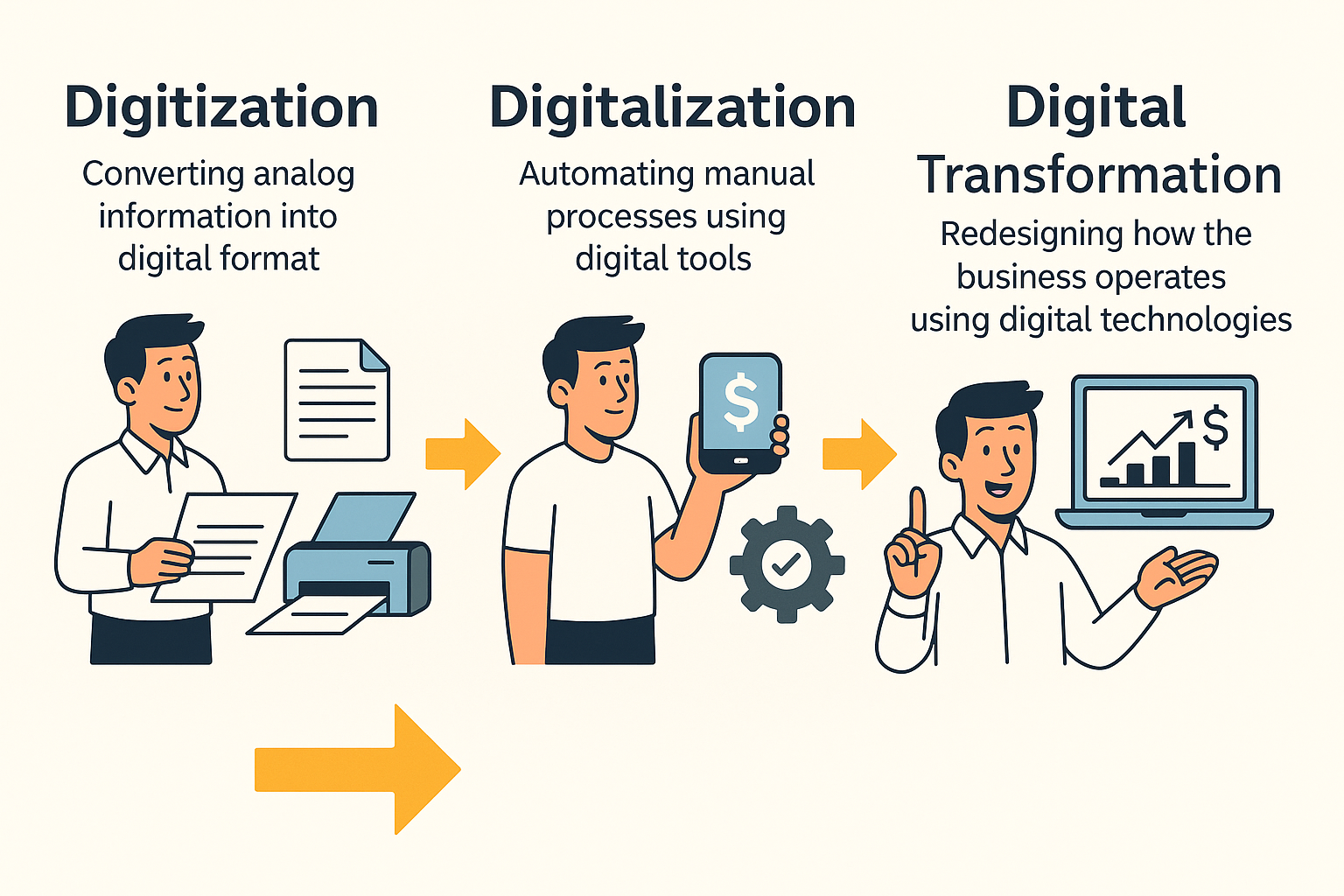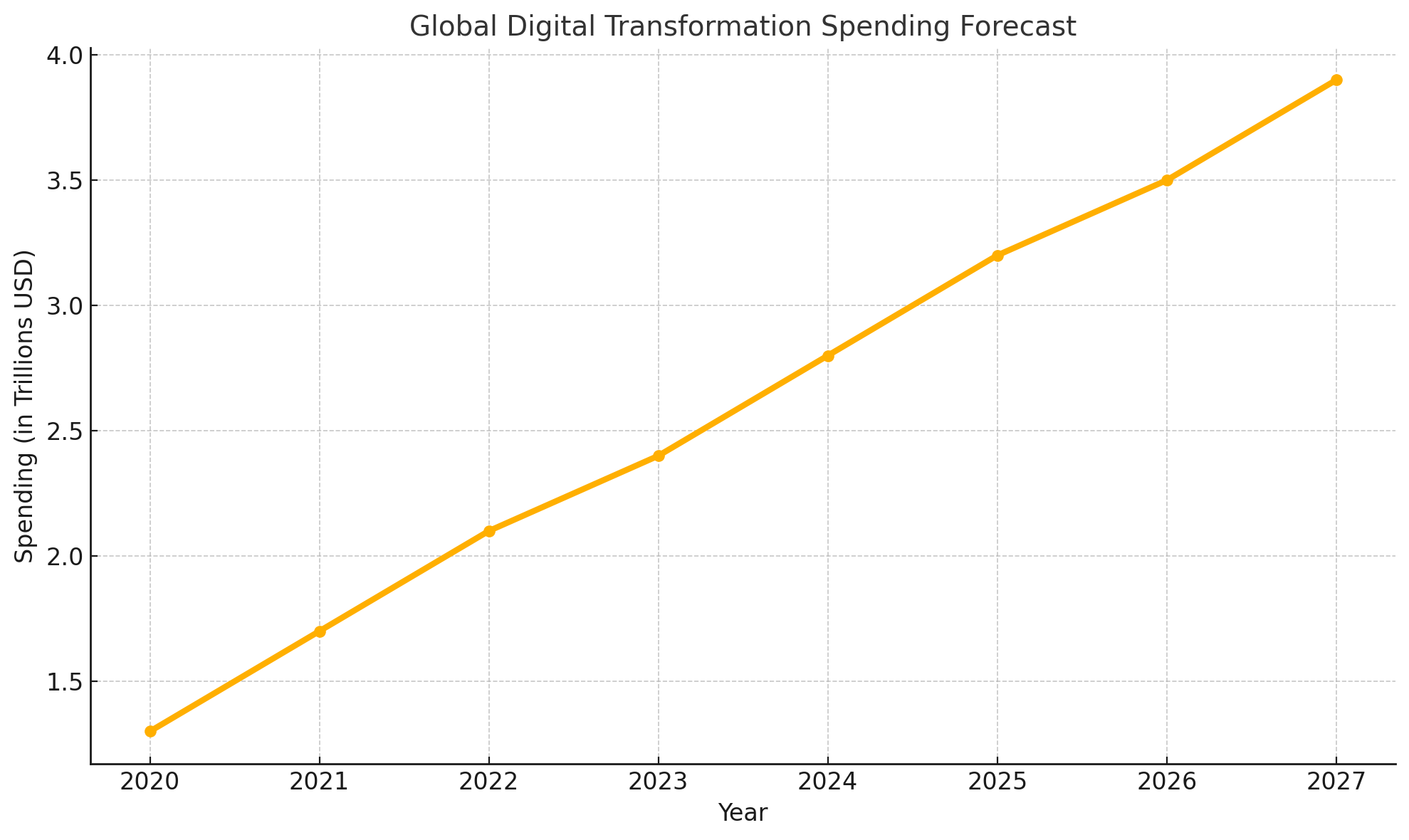What Is Digital Transformation? Definition, Value & Real Examples
2025-04-25 · By Anil Kancharla · 4 min read
❤️ 0 Likes · 👁️ 0 Views

Digitization
Digitization is the process of converting analog information into digital (binary) format.
The goal is to make information storable, searchable, and shareable electronically.
Example:
Scanning a paper document using a scanner and saving it as a PDF.
✅ Digitalization
Digitalization is the use of digital technologies to automate or enhance existing manual processes — achieving the same goals more efficiently.
Example:
Transferring funds between banks — once a manual task requiring in-person visits — is now done instantly via mobile or web apps.
✅ Digital Transformation
Digital Transformation is the strategic rethinking of how a business operates using digital tools — with the goal of maximizing value, optimizing resources, and improving efficiency across the organization.
It’s not just process automation — it’s business model evolution.
Example:
Shifting from selling physical products to offering subscription-based digital services with real-time customer analytics.
🚀 Why Do Businesses Need Digital Transformation?
Is It Real or Just Hype?
Digital transformation has become one of the most overused phrases in business — but behind the buzzword lies a very real and urgent shift. The question is no longer if businesses should embrace it, but how they can do it right.
📊 It's Backed by Big Numbers
Global spending on digital transformation is expected to reach $3.9 trillion by 2027 (Statista), with enterprises allocating significant portions of their IT budgets toward automation, cloud migration, and AI-powered operations.
This isn't a trend — it's a global reset of how business gets done.

🔄 Technology Is No Longer Optional — It's Essential
Technology is now so integrated into our lives that individuals go through their own personal digital transformations all the time:
- Buying a new smartphone
- Switching from Android to iOS
- Making online payments or using smart appliances
These changes are often expensive, time-consuming, and complex. But we still do them — because they add value.
The same logic applies to businesses.
💡 What Is the Value of Digital Transformation?
Here are 3 concrete reasons why businesses pursue digital transformation:
1. Cost Reduction
As Michael Porter describes in his competitive forces model, businesses may not be able to control external pressures — but they can control internal operations.
By redesigning inefficient processes, businesses can reduce operating costs and improve margins.
Example:
- Company A earns $10 revenue, spends $8 = $2 profit
- Company B earns $10 revenue, spends $7.5 = $2.5 profit
🔎 Investors will likely favor Company B, not just for higher profitability, but for cost discipline — a key driver of valuation.
2. Efficiency Through Technology
With IoT, AI, and automation, companies can:
- Track machine performance in real time
- Optimize technician schedules
- Forecast inventory needs
- Use data to make proactive decisions
A telecom company, for example, can assign field technicians based on ticket severity, geographic proximity, and equipment needs — all automated through a smart workflow.
This isn’t just tech for the sake of tech — it’s a direct path to process excellence.
3. Time Saved = Innovation Gained
If your people, machines, and capital are working efficiently, you save time.
That saved time can be reinvested in innovation, training, or customer experience.
Efficiency fuels innovation. Innovation drives growth.
📈 The End Result?
- ✅ Higher margins
- ✅ More productive teams
- ✅ Greater agility in uncertain times
- ✅ A stronger brand with long-term value
✅ Final Word: Digital Transformation Is Real
Digital transformation is not a myth, and it’s definitely not a buzzword to ignore.
It’s as real and vital as any business function — and the only question is not if your company should transform…
…but how well you’ll do it before your competitors do.
💌 Enjoyed this article?
If you found this post valuable, subscribe to my newsletter for more insights on digital transformation, AI, and business innovation.
👉 Subscribe to the newsletterOr let’s connect on LinkedIn — I share weekly content that’s practical for CIOs, CFOs, and transformation leaders.
🔗 Connect with me on LinkedIn